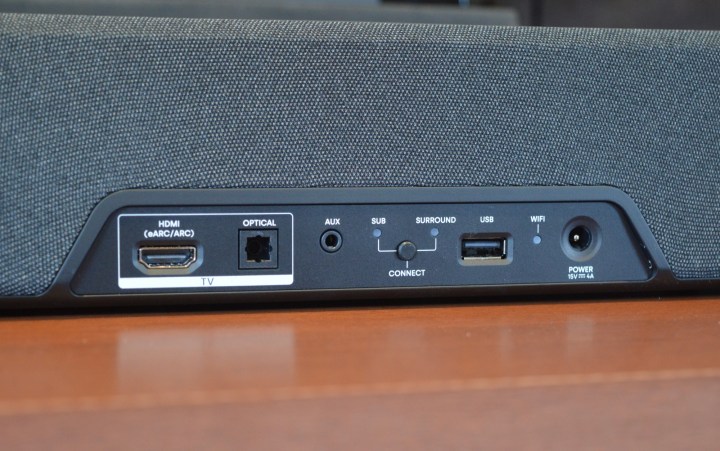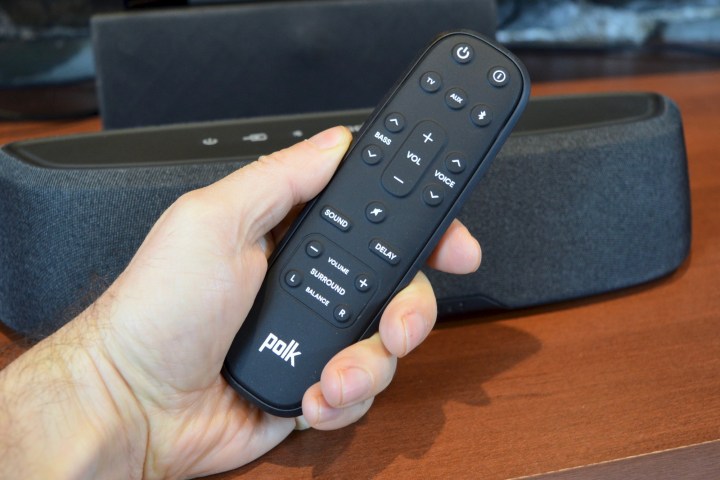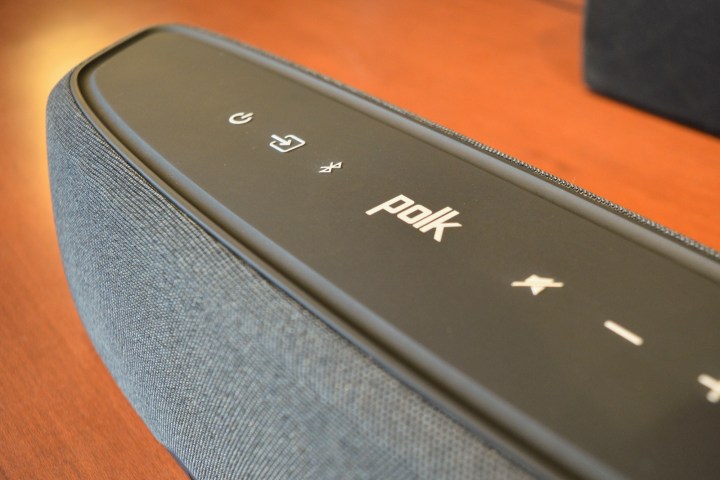- Dolby Atmos and DTS:X
- Powerful subwoofer for its class
- Wi-Fi/AirPlay 2/Chromecast
- Clear vocals and dialog
- Tiny footprint
- Optional surround speakers
- Virtualized Atmos not very immersive
- Midrange detail could be better
- No HDMI inputs
- No EQ controls
By now, a lot of folks have realized that soundbars are the easiest way to improve your TV’s sound. Sure, they might not be quite as good as a full, conventional home theater system, but for most people, the simplicity they offer more than outweighs any concerns on that front.
But most soundbars are almost as wide as the TV to which they’ll be connected. And if you want Dolby Atmos, you might end up spending $1,000 or more.
Polk’s new $499 MagniFi Mini AX is an attempt to solve both concerns by sticking a virtualized Dolby Atmos/DTS:X sound system inside an enclosure that’s smaller than some portable Bluetooth speakers. Does it work? And how does it stack up to similarly-priced systems? Let’s check it out.
Design

The MagniFi Mini AX really does live up to its name. The main speaker that sits in front of your TV is crazy small as far as soundbars go. As you can see in the accompanying photos, at just 14.4 inches wide, 4.1 inches deep, and 3.1 inches tall, it’s shallower and shorter than a standard, wired center channel speaker.
I’m not in love with its trapezoidal shape, which keeps reminding me of a Badonkadonk Land Cruiser. Other than that, it draws very little attention to itself. A set of clearly labeled buttons sit beneath a rubberized membrane on the top surface: Power, input selection, Bluetooth, mute, and volume up/down. Behind its dark gray acoustic fabric grille is a scrolling OLED display that provides easy-to-read info for your current input, volume/subwoofer/voice levels, and the speaker’s various sound modes.

If your TV is mounted to the wall, the Mini AX might not be the best choice, as it’s not designed to be wall-mounted — and Polk doesn’t sell any kind of optional mounting hardware. (Though I suppose there’s nothing stopping you from installing a small shelf for it to sit on.)
Unlike the vast majority of soundbars, the Mini AX doesn’t have its own internal power supply, which is partially how Polk was able to make it so small. That means there’s a power brick you’ll need to hide.
It’s intended purely as an extension of your TV’s audio system, but with a few extra bells and whistles.
The included wireless subwoofer mirrors the soundbar’s unusual shape with a narrow yet tall, tapering profile. Again, it’s not really my cup of tea looks-wise, but I’m willing to overlook it thanks to its performance.
The remote control is standard fare for Polk: Boring but functional, with a fully rubberized membrane over raised buttons. The layout is simple and intuitive, but there’s no backlighting for use in darkened rooms. I’m guessing that rubber membrane will be way easier to clean when you inevitably spill liquid on it.
Connections and controls

Some soundbars are designed as A/V receiver replacements with several HDMI inputs — Polk’s MagniFi Max SR is a good example of this. The Mini AX takes a different approach. It’s intended purely as an extension of your TV’s audio system, but with a few extra bells and whistles. In practice, this means you get two choices for connecting your TV: HDMI ARC/eARC or optical.
If you want to listen to Dolby Atmos or DTS:X content, the HDMI port is a must — neither of these sound formats are compatible with optical connections, which simply lack the bandwidth needed to transmit the extra audio information. Your TV also will need an HDMI ARC/eARC port and possess the ability to transmit Dolby Atmos or DTS:X via that port. Not every Dolby Atmos TV can do this, so double-check your TV’s specs to avoid disappointment. Because the soundbar has no HDMI inputs, if your TV can’t transmit Dolby Atmos, there’s no other way to deliver an Atmos signal to the speaker.
Basic set-up of the MagniFi Mini AX is really easy.
Unfortunately, the unused port (whether that’s HDMI or optical) becomes superfluous. You can’t use it as a secondary input for connecting devices like streaming audio, CD, or Blu-ray players.
There is another input option in the form of a 3.5mm analog jack, which you could use with a variety of devices that have analog outputs, including TVs and smartphones that still have headphone jacks.
Ignore the USB port — it’s reserved for doing software updates in the event that you don’t have a Wi-Fi connection. But I hope that you do have a Wi-Fi connection if you’re thinking of buying the MagniFi Mini AX, because it also supports high-quality music playback over Apple AirPlay 2 and Chromecast, which are both much better alternatives to Bluetooth. If Wi-Fi isn’t an option, or you simply want a quick and easy way to stream from your phones or other devices, Bluetooth is available as well.
Setup and configuration

Basic setup of the MagniFi Mini AX is really easy. Once you’ve pulled the soundbar and subwoofer out of the box, plug the soundbar into your TV via your preferred connection, then plug both speakers into the nearest wall outlets (plug the soundbar in first). Polk includes an HDMI cable in the box, but you’ll have to supply your own optical cable if that’s the way you want to go. Throw the included batteries into the remote, and you’re in business.
The MagniFi Mini AX is amazing for movies and shows.
Your TV should automatically recognize that it’s connected to a soundbar. If it doesn’t, you’ll need to change the audio settings to use the HDMI/optical output. To ensure you’re getting a Dolby Atmos signal when available, you may need to adjust the audio output settings to use bitstream instead of LPCM.
Once you’re done with the wired portion of the setup, you can also enable Wi-Fi streaming via Apple AirPlay 2 and/or Chromecast Built-in. My review unit had trouble with AirPlay, but using the Google Home app to configure the Mini AX with Chromecast was quick and easy. The Home app invited me to set up the new speaker as soon as I opened it. A few minutes later, the soundbar downloaded and installed the latest firmware, and I was good to go.
Sound quality

The MagniFi Mini AX is amazing for movies and shows. If you read reviews of previous MagniFi speakers, you’ll probably note a common thread: They sound way bigger and better than their diminutive size would normally suggest. The MagniFi Mini AX is no exception.
The soundbar is equipped with two tweeters and three midrange drivers for left, center, and right channels. Thanks to Polk’s Stereo Dimensional Array (SDA) technology, which projects sound outward at various angles — not just straight ahead — this speaker totally fills a medium-sized room with punchy, dynamic sound.
Its strength lies in its reproduction of both low and high frequencies. The subwoofer has a commanding presence, generating bass that you can both hear and feel — and that’s when it’s set to the default neutral level. If you use the remote to boost it, there’s a good chance you’ll start to rattle any loose glass you’ve got in your room.
But at no time does it feel like the sub is taking over. Polk manages to keep it closely tied to the soundbar’s range, always supporting the soundtrack and never smacking you in the face with bass.
The Mini AX has four sound modes: Music, movie, 3D, and night. Since there’s no way to adjust EQ directly, you’ll need to flip around between these modes to see what sounds best to you. With the exception of night mode, which intentionally reduces dynamic range to keep your neighbors from knocking on your door, I found 3D to be the most satisfying for movies and shows, as it takes advantage of the soundbar’s ability to create a wide soundstage. This is not only helpful for making standard 2-channel and 5.1 Dolby Digital content feel more immersive, but it’s also essential as far as I’m concerned for getting the most out of Dolby Atmos and DTS:X.
Regardless of the music source, there was a slight hollowness to the sound.
Having said that, I want to keep your Dolby Atmos expectations realistic. There are no up-firing drivers to create the signature Atmos height channel effect, so Polk uses digital signal processing to virtualize these channels. But even the best-virtualized height and surround channels can only do so much.
With the Mini AX, sounds won’t be heard from overhead (or beside/behind you unless you spring for the $200 optional wireless surround speakers). There’s an awesome moment in No Time To Die, when James Bond’s classic Aston Martin is surrounded by enemies and pummeled by a hail of automatic weapons fire. In an Atmos system with discrete speakers, those bullets sound like they’re whizzing in from all around you, letting you feel what it might be like to be Bond inside the car. The Mini AX faithfully reproduces the sound of those bullets, but on its own, it can’t replicate that feeling of true immersion.

Curiously, Polk’s less expensive $400 Signa S4 soundbar actually does a better job of rendering Dolby Atmos, but with its less powerful subwoofer, it can’t match the Mini AX’s visceral low-end punch.
Though it may not be the best Atmos soundbar, its wide and tall soundstage and excellent clarity make it ideal for Broadway-style musicals. We screened Spielberg’s West Side Story and found the Mini AX was just the ticket for enjoying the cast’s high-energy performances. That clarity makes speech and dialog another bright spot. Again, out of the box, voices are very clear, and you may not feel the need to tweak the settings. But if you find yourself watching an especially poor mix, where the voices tend to get swallowed by the soundtrack or sound effects, the Voice Adjust feature can bring those voices back into sharp focus without diminishing the rest of the audio.
Streaming music is also very enjoyable, but seasoned listeners may notice a lack of midrange detail. I tested a variety of content, including lossless streaming audio over Wi-Fi using Chromecast, lossy streaming via Bluetooth, and Dolby Atmos Music via the Tidal app on the Apple TV 4K. Regardless of the source, there was a slight hollowness to the sound. 3D mode creates a more immersive experience, but it also increases that feeling that something’s missing, so Music mode will likely be your best bet. I can’t say for sure that having access to a full set of equalizer controls would make up for this hole in the sound, but I would have liked to try.
As with other soundbars that let you listen to music over HDMI, Wi-Fi, and Bluetooth, the best results come from the HDMI connection. Wi-Fi runs a close second, and Bluetooth is perfectly acceptable for casual listening — but I don’t recommend it for a serious listening session.
Our take

With its tiny footprint but huge sound, the Polk MagniFi Mini AX is an excellent choice for taking your TV’s sound to the next level while keeping dialog clear and intelligible, but its lack of EQ settings and midrange weakness keep it from being an ideal music machine.
Is there a better alternative?
If immersive Dolby Atmos is your primary goal, consider the $500 Vizio M-Series M512a-H6. It lacks the Mini AX’s space-saving design, but it will produce much more immersive audio thanks to its dedicated up-firing drivers and surround speakers. We haven’t tested this exact model, but we’ve reviewed many of Vizio’s other Atmos models like the flagship Elevate and the affordable M-Series M51a-H6, and they’re generally excellent performers. Vizio’s soundbars don’t have Wi-Fi for AirPlay or Chromecast streaming, however, so they should be considered primarily TV enhancers.
If you want a small footprint soundbar that can virtualize Dolby Atmos and deliver a musical performance that is sure to satisfy, the $449 Sonos Beam Gen 2 is an excellent alternative. It can’t compete with the Mini AX’s rumbling subwoofer, but it has an expansive soundstage, and like all Sonos products, it’s a superb music companion that works with every streaming service you can think of. Plus, it’s a smart speaker with your choice of Amazon Alexa or Google Assistant.
How long will it last?
As long as Polk continues to provide software updates when needed, the MagniFi Mini AX should last for many years to come. My experience with external power supply bricks like the one that Polk uses for the soundbar is that they can sometimes fail prematurely, but at least that’s easier to replace than if an internal power supply should go on the fritz. Polk backs the MagniFi Mini AX with a one-year warranty on the amplifiers and a three-year warranty on the speakers.
Should you buy it?
Yes. If you’re looking to give your movies and shows a major upgrade while keeping the soundbar as small as possible, the MagniFi Mini AX fits the bill.










